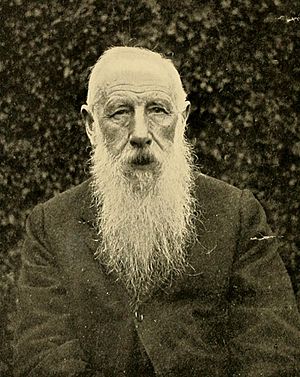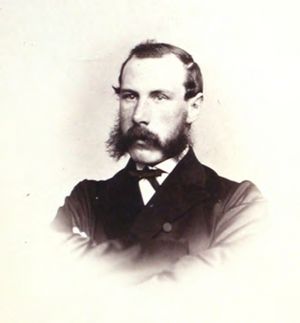David Sharp (entomologist) facts for kids
Quick facts for kids
David Sharp
|
|
|---|---|
 |
|
| Born | 18 October 1840 |
| Died | 27 August 1922 |
| Nationality | English |
| Alma mater | University of Edinburgh |
| Scientific career | |
| Fields | Entomology |
David Sharp (born October 18, 1840 – died August 27, 1922) was an English doctor and a scientist who studied insects. He was especially interested in beetles. He wrote over 250 scientific papers about insects. For 30 years, he was also the editor of a very important science publication called the Zoological Record. He was one of the most active insect scientists of his time.
Contents
Early Life and Education
David Sharp was born in Towcester, England. He spent his early childhood in Stony Stratford. When he was about 12, his family moved to London. There, he went to St. John's Foundation School.
At 17, David started helping his father, who worked with leather. Around this time, he also began collecting beetles. He loved exploring places like Ken Wood and the sandy beaches near Deal and Dover to find insects.
David was not very interested in business. Instead, he decided to study medicine. He studied at St Bartholomew's Hospital for two years. Then, he went to the University of Edinburgh, where he became a doctor in 1866.
Career and Research
After becoming a doctor, David Sharp helped a friend with his medical practice in London. He thought about working at the British Museum to study insects. Later, he even applied to be a museum curator in Glasgow.
He then took a job as a medical officer at the Crichton Asylum in Dumfries. This job gave him plenty of free time. He used this time to study insects, which he loved. During this period, he wrote some of his first scientific papers.
In 1883, David Sharp moved back to England. He first lived in Southampton, but it was too far from London. So, he moved to Dartford.
In 1885, he was invited to work at the Cambridge University Museum of Zoology. He became the Curator there. He spent 19 years in Cambridge, working on his insect studies. In 1909, he retired to Brockenhurst. He built a house there, right next to the New Forest, where he lived until he passed away in 1922.
Important Roles and Honors
David Sharp was a very respected scientist. In 1862, he became a member of the Royal Entomological Society of London. He was even the president of this society in 1887 and 1888. As president, he gave speeches about insect collections and how insects use their senses, especially sight.
He also served on the society's council and was a vice-president many times. In 1867, he was the Secretary of the society while living in London.
In 1886, he became a member of the Zoological Society. He was also a member of the Linnean Society of London starting in 1888. He was connected to many important insect societies around the world.
In 1890, he received a very high honor. He was chosen to be a Fellow of the Royal Society. The next year, the University of Cambridge gave him an honorary Master of Arts degree.
Personal Life and Friendships
David Sharp knew many famous British naturalists of his time. These included Thomas Henry Huxley, Henry Walter Bates, and Alfred Russel Wallace. He was also a close friend of the philosopher Herbert Spencer. In 1904, Sharp wrote an article about Spencer's ideas on biology and how they related to Charles Darwin's work.
When he was a teenager, Sharp went on a trip to Switzerland with his father. He really enjoyed it. Later in life, he visited France to see another scientist, Oberthur.
Sharp was very sad when his friend George Robert Crotch passed away. They had worked closely on insect studies. They also went on several trips together to places like the New Forest, Rannoch, and Spain. Sharp often shared funny stories about how hard it was to find food and places to stay in those areas long ago.
In Brockenhurst, David Sharp worked hard in his insect laboratory. One of his daughters helped him. They studied the lives and bodies of many insects, especially beetles. His large collection of beetles later went to his daughter.
Today, David Sharp's huge collection of insects is kept at the Natural History Museum, London. It includes thousands of special type specimens. These are very important for identifying different insect species.
Key Publications
David Sharp wrote many important scientific papers and books. Here are some of his most well-known works:
- 1869: A detailed study of British Homalota beetles.
- 1874: A paper on the Staphylinidae beetles found in Japan.
- 1876: Contributions to the insect life of the Amazon Valley.
- 1880–1882: A large book about aquatic carnivorous beetles called Dytiscidae.
- 1882–1886: A major work on Staphylinidae beetles for the Biologia Centrali-Americana series, which described insects from Central America.
- 1887: A section on Pselaphidae beetles for the Biologia Centrali-Americana.
- 1891: A section on Synteliidae beetles for the Biologia Centrali-Americana.
- 1896–1913: He worked with Robert Cyril Layton Perkins and Alfred Newton on Fauna Hawaiiensis, a study of animals in Hawaii.
- 1899: A paper on how insects are classified.
- 1912: With Frederick Arthur Godfrey Muir, he wrote about the anatomy of male insect reproductive organs in beetles.
Sharp also helped create two important lists of British beetles in 1871 and 1893.


